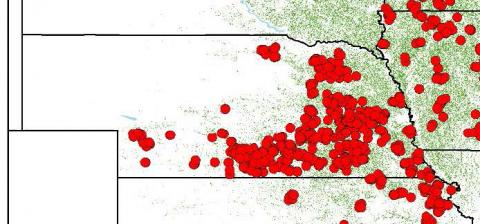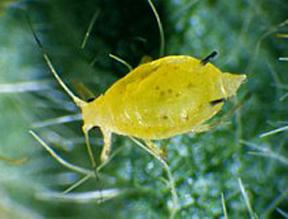Northeast Nebraska Insect Pest Update
January 8, 2018
Part of the 2018 Crop Production Clinic Proceedings, this article reviews insects to expect in northeast Nebraska crops and links to resources on management.
Scout Emerging Corn for Early Season Insects
May 11, 2017
As corn begins to emerge, be alert to the potential for damage from early season insects such as cutworms, wireworms, or white grubs. Wireworms and white grubs are most often associated with fields that have been in pasture or CRP where the grasses were allowed to grow for more than one year. It is rare to see these problems in continuous corn, but exceptions happen. Since wireworms and white grubs feed underground and cutworms feed on or below the soil surface, scout for plant damage and then dig in soil around the plant to identify the insect causing the damage.
Scouting Advised for Alfalfa and Clover Leaf Weevils
April 20, 2017
Alfalfa weevils have been reported damaging alfalfa in north central Kansas and western Nebraska. As temperatures warm up, expect to see alfalfa weevil larvae in southern Nebraska and slightly later, in northern Nebraska. Even with the pressure of planting row crops, it is essential that producers growing high quality alfalfa hay make time to monitor fields for weevils now and over the next few weeks. See the article for a table of treatment thresholds for various alfalfa prices.
Help Us Identify Yield-Limiting Factors in Nebraska Soybean Fields
October 5, 2016
Nebraska soybean producers are being asked to answer a survey about their soybean fields and contribute to a benchmark study of current soybean production in Nebraska. Researchers from 10 north central states, including Nebraska, are collecting the data to identify factors that may be impeding growers from reaching full yield. See what they've learned in the first two years of the study and how they hope to use the information.
Prepare Grain Bins and Equipment For Harvest
August 31, 2016
Proper cleaning of all harvesting equipment and grain bins and preparation of bins is a key to preserving stored grain quality. See these recommendations and lists of commonly used products for treating bins.
Soybean Aphid Scouting and Management
July 28, 2016
The current recommended economic threshold for late vegetative through R5 stage soybeans is 250 aphids per plant with 80% of the plants infested and populations increasing. Depending on economic conditions, this generally gives you about five to seven days to schedule treatment before populations reach economically damaging levels.
Soybean Aphids Found in Northeast Nebraska; Scouting Warranted
July 28, 2016
This week soybean aphids were found in several northeast Nebraska fields at low numbers. Although it has been too hot for soybean aphids to thrive, populations could quickly increase with cooler temperatures. Scouting is recommended at this time.
Decision Making for Soybean Defoliating Insects
July 15, 2016
July is when growers start to see a variety of defoliators in Nebraska soybean fields. It's easy to overestimate the amount of defoliation and soybean plants can compensate for some leaf area loss. This article describes how to assess defoliation and provides basic treatment thresholds.









